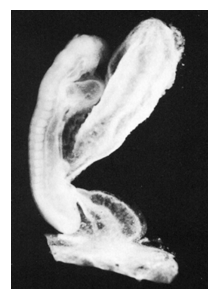The Stages of Human Embryonic Development
Stage 11 embryos have estimated greatest lengths within the range of 2.2 to 5 mm, although most are probably between 3.0 to 4.5 mm before sectioning. They have an estimated postfertilization age between 26 and 30 days. The characteristic feature of stage 11 is the presence of between 13 and 20 pairs of somites, or body segments, along the body axis. Sclerotomes are forming in the ventromedial part of the somites as the somite remnants move dorsolaterally. The rostral neuropore closes during this stage.
Also during stage 11 the optic vesicle forms in the wall of the diencephalon and the otic placode, or pit, forms as a region of thickened ectoderm lateral to the rhombencephalon. The adenohypophyseal primordium is forming just rostral to the oropharyngeal membrane that is beginning to disappear, the right and left horns of the sinus venosus are continuous with their respective atria, and the hepatocystic diverticulum can be identified in the endoderm at the fore- mid-gut junction. Mesonephric vesicles and duct appear in the nephrogenic cord.
| Browse the section images |
| 3D reconstructions |
| More info ... |
